How to Stay Safe in Yellowstone Bear Country
Yellowstone bears are a common concern of visitors to the park. If you’ve ever seen The Revenant with Leonardo DiCaprio, you’ll understand why. Bears are simultaneously a major draw to Yellowstone for some and a concern for others. All in all though, the fear is largely exaggerated in popular culture. I don’t want to give the impression that bears aren’t dangerous. Bears can be incredibly dangerous and must be given their space and respected in Yellowstone. However, bears are not roaming the park pulling people out of their tents and devouring them on a regular basis. In fact, since the park was founded in 1872, only eight people have been killed by bears in Yellowstone. Bears shouldn’t deter anyone from visiting Yellowstone, but those who do visit must be well versed in safety in bear country. With that in mind, let’s talk safety.
Yellowstone is home to two species of bears: black bears and grizzly bears. For a guide to differentiating the two species (hint: it’s not by color) check out our article on the subject here. Most of the guidelines for safety in bear country apply to both species, but a handful are specific to one or another, so it’s handy to be able to tell them apart.
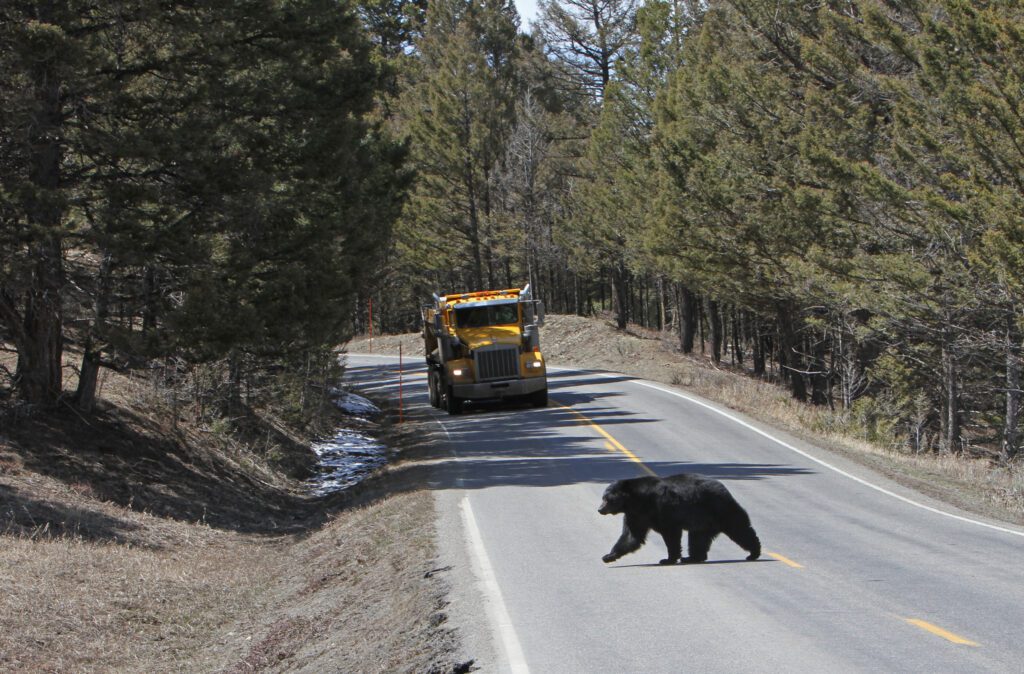
1. Store and Handle All Bear Attractants Properly
First, let’s talk about bear attractants. A bear attractant is anything with a scent that could attract a bear. This includes all food, but also includes things like deodorant, toothpaste, perfume, flavored sports drinks, alcoholic drinks, gum, etc. Bears are curious critters with powerful noses. When camping in Yellowstone all bear attractants must either be kept in a vehicle, in a bear box, or hung from a tree in a bear bag while you’re sleeping or away from camp. Also consider safety while cooking. If you fry up a beautiful pan of crispy bacon and pour the grease in the fire you’re creating a powerful and unremovable bear attractant right in the center of your camp. Ensure that any waste or byproducts from cooking are collected and stored properly.
If you’re in the backcountry, you’ll want to set up your kitchen at least 100 yards from your camp so as not to draw any bears towards where you’ll be sleeping. Pay attention to the wind and place your kitchen area downwind of your camp. This should help prevent bears being drawn through your camp towards your cooking space. Also, either prevent food from getting on your clothes while cooking or change your clothes afterwards and store dirty clothes properly. You don’t want to become a bear attractant! Dirty water from doing dishes should also be dumped at least 100 yards from camp.
Many backcountry sites in Yellowstone have a bear pole for hanging food and other attractants. Bring at least 35 feet of rope for hanging your bag. If a pole isn’t available, hang your food from a tree at least 25 yards from camp, again downwind. The bag must be at least 10ft above the ground and 4ft away from any trunks. A helpful guide on how to hang a bear bag can be found here. Another option is a bear proof container, which also should be stored at least 25 yards from camp.
If you’re front country camping, keep your attractants either in your vehicle or in one of the provided bear boxes. Keep a clean camp to avoid attracting bears and the ire of park rangers.
When camping in Yellowstone all bear attractants must either be kept in a vehicle, in a bear box, or hung from a tree in a bear bag while you’re sleeping or away from camp.
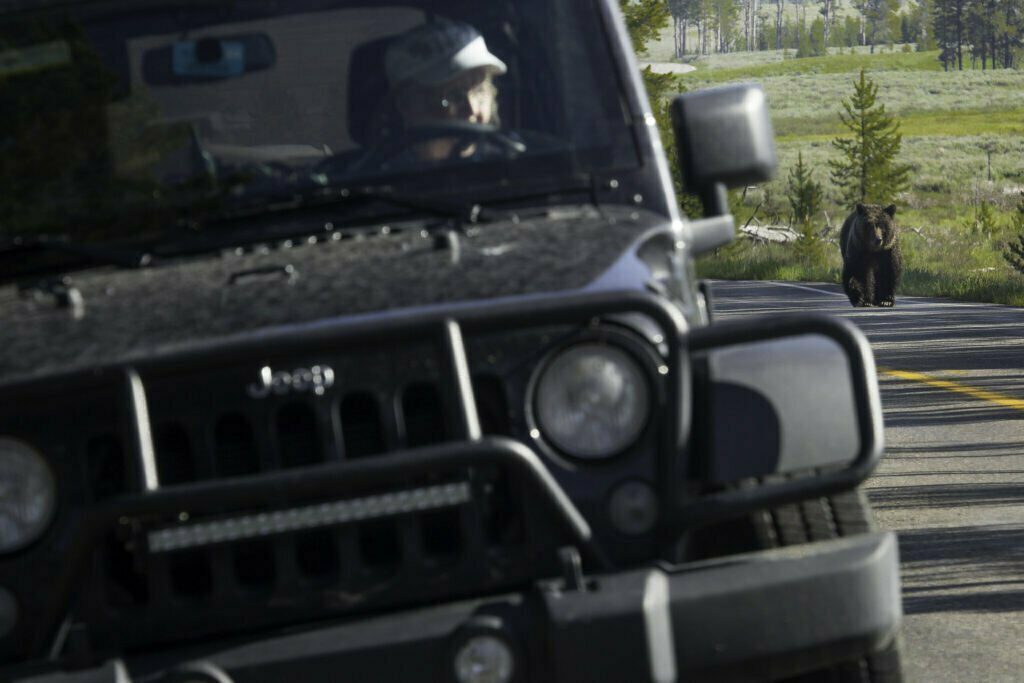
2. Travel in Bear Country
Always carry bear spray in bear country. Whether you’re day hiking, walking around camp, or out on a multi-day backpacking trip, you should have at least one can of bear spray per person in your group. Know how to use your bear spray. A great guide on using bear spray from NPS can be found here.
When traveling in bear country it’s recommended to move in groups of at least three people. Bears are likely to avoid groups of this size or larger. Additionally, make noise as you travel, especially in areas with low visibility to avoid spooking an unsuspecting bear. Talking or shouting ‘hey bear’ as you travel can warn bears of your approach and lead them to leave the area prior to your arrival. You can also sing loudly if that’s your style.
Some areas of Yellowstone can be closed during part of the year due to high bear activity, so always check the status of any area you’re visiting before departing.
Handguns are not an effective bear deterrent, being far less effective than bear spray. Additionally, the discharge of firearms inside Yellowstone is illegal. So it’s best to leave the handguns behind and carry additional bear spray if you’re concerned about bear activity.
Handguns are not an effective bear deterrent, being far less effective than bear spray.
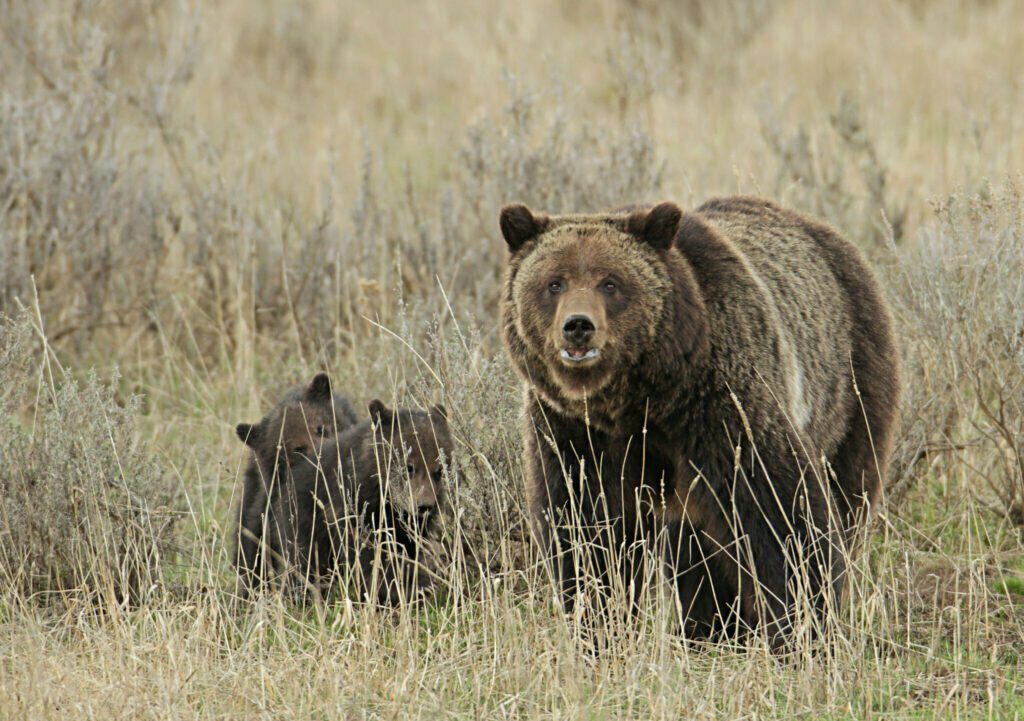
3. Bear Encounters
Encountering Yellowstone Bears At A Distance
If you encounter a bear at a distance and it hasn’t noticed you, keep it that way. Stay out of sight of the bear and either turn around or detour around it. If you can slowly travel upwind of the bear to allow your scent to reach it this may encourage it to leave the area. If the bear notices you, slowly and calmly retreat from the area. Never approach a bear.
Surprise Attacks
If you surprise a bear while hiking do not panic or run, but slowly back away from the bear. Running can cause the bear, a predator, to instinctively chase you. Bears can easily run over 30mph, so trying to outrun it is futile. Instead calmly back away from the bear, talk in to it in a calm manner, draw your bear spray from its holster, and remove the safety.
If the bear charges you stand your ground, do not run. Most bear charges are bluffs, and the bear will stop short of you or turn away before reaching you. When the bear is around 60ft away begin spraying your bear spray. Create a cloud the bear will need to pass through to get to you. Consider wind direction when spraying. You don’t want to spray yourself in the process.
If the bear makes contact with you, drop to the ground, lie on your stomach, and use your arms to protect the back of your neck and your face. If the bear is attacking defensively it is likely to leave you alone once it’s convinced you’re not a threat. Do not get up until you are certain the bear has left the area. Once you do get up, leave the area promptly, but do not run.
Most bear charges are bluffs, and the bear will stop short of you or turn away before reaching you.
Curious/Predatory Yellowstone Bears
If the bear approaches you slowly and persistently, head and ears raised, it may be curious or predatory. A bear like this will likely not display the defensive displays above such as slapping the ground, huffing, or bluff charging.
If you encounter a curious or predatory bear it is imperative to find safety or leave the area as soon as possible. Climbing a tree is unlikely to work, as most bears are proficient tree climbers, likely better than you. Again, do not run from the bear. If you can’t leave the area quickly enough, your entire group should gather and yell at the bear. Draw and remove the safety from your bear spray and prepare to use it. If the bear is approaching slowly do not use your spray until it is 20ft to 30ft away. If you’re wearing a pack, keep it on. It can provide additional protection to your back in the event of an attack.
If a curious or predatory bear attacks, fight back with all available means. Bear spray, knives, rocks, etc., are all on the table. A predatory bear attack will typically persist until the bear is run off, injured, or killed. It’s often said in this situation, ‘Fight back like your life depends on it, because it does.’
Yellowstone Bear Encounters in Camp
If a bear enters your camp, gather your things, and leave as soon as possible. If it enters at night and it remains quiet, it may pass through and move on. However, if it attacks you in your tent fight back and consider it a predatory bear. As soon as the bear leaves remove yourself from the area promptly.
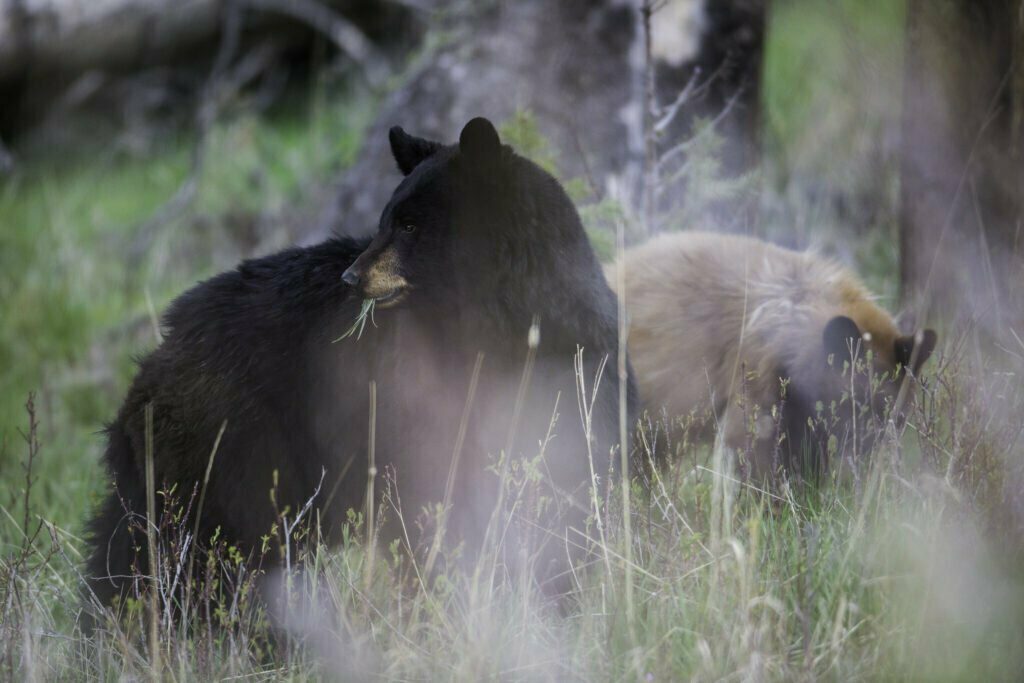
4. Black Bears vs. Grizzly Bears
There are some slight differences in how to handle encounters with black bears vs. grizzly bears. If you are attacked by a black bear, do not play dead. Either attempt to escape the bear or fight back. When fighting the bear attempt to kick, punch, or hit its face and nose.
With defensive grizzly bears, not curious or predatory, play dead if the bear makes contact. Attempting to fight a grizzly that is only attacking defensively can greatly increase the severity of the attack. Since 1970 in Yellowstone, people who played dead during a defensive bear attack only received minor injuries 75% of the time. Those that fought back during such encounters received very severe injuries 80% of the time. If the grizzly attack persists though, it can become necessary to fight back.
Since 1970 in Yellowstone, people who played dead during a defensive bear attack only received minor injuries 75% of the time. Those that fought back during such encounters received very severe injuries 80% of the time.
In Summary
- Always carry bear spray in bear country
- Always travel in groups of three or more
- Make noise as you travel; Do not surprise a bear
- Store bear attractants properly; Do not cook where you sleep in the backcountry
- Dispose of dish water 100+ yards from camp
- Either hang attractants from a bear pole or tree 25 yards from camp, or store in a bear proof container 25 yards from camp
- If in a front country site, use provided bear boxes
- If you surprise a bear
- Slowly retreat
- Talk to the bear
- Stand your ground if it charges and deploy bear spray
- If it makes contact play dead if its a grizzly, fight back if it’s a black bear
- If it’s brown lay down, if it’s black fight back
- If you encounter a curious or predatory bear, or are attacked in your tent: leave the area, group up and yell, and fight back if attacked.
None of this is to discourage you from visiting, hiking, or recreating in bear country. Bear attacks aren’t incredibly common and fatal bear attacks in Yellowstone are downright rare. It’s important to stay aware in bear country though, and know what to do if you encounter Yellowstone bears.
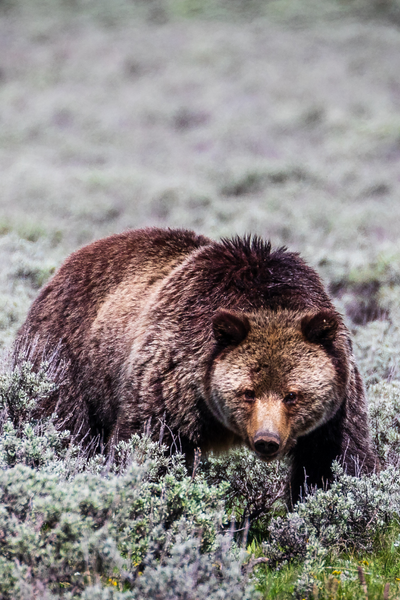
Read More

Exploring Yellowstone in the Winter
The vast majority of the park’s annual visitors come during the much milder summer months, leaving the park to the die-hard Yellowstone admirers throughout the winter. This absence of visitors makes exploring Yellowstone in the winter a unique and rewarding experience.

The Yellowstone Volcano Erupted More Recently Than You Think
The Yellowstone Volcano Erupted More Recently Than You Think The geologic history of the land underlying Yellowstone National Park is defined by the influence of

How to Stay Safe in Bear Country
Here’s a short guide on how to stay safe from Yellowstone bears while visiting America’s first national park.
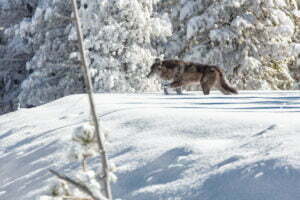
A Short History of Wolves in Yellowstone
A Short History of Yellowstone Wolves The story of Yellowstone wolves, indeed wolves across most of the American West, is a story of misunderstanding, extermination,
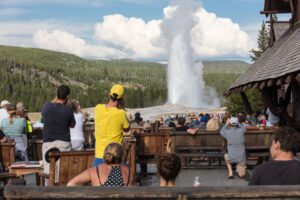
Is The Yellowstone Volcano About to Erupt?
Is The Yellowstone Volcano About to Erupt? Suddenly, as if out of nowhere, the ground shakes and buckles under Yellowstone National Park. Steam bellows out
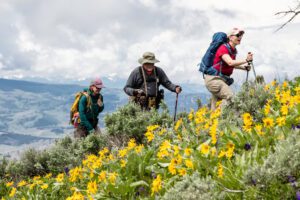
5 Reasons You Should Visit Yellowstone
Five Reasons You Should Visit Yellowstone Whether you’re on a family vacation, a road trip with friends, or just out to explore the country, Yellowstone
Want To Discover Yellowstone In Person?
Yellowstone offers more than anyone could experience in a lifetime, much less a day. Don’t waste a moment of your trip—discover the wonders of America’s first national park on one of our guided Yellowstone tours with our trusted and experienced guides.

